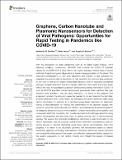Graphene, Carbon Nanotube and Plasmonic Nanosensors for Detection of Viral Pathogens: Opportunities for Rapid Testing in Pandemics like COVID-19
Author(s)
Bardhan, Neelkanth Manoj; Jansen, Peter; Belcher, Angela M
Downloadfnano-03-733126.pdf (2.004Mb)
Publisher with Creative Commons License
Publisher with Creative Commons License
Creative Commons Attribution
Terms of use
Metadata
Show full item recordAbstract
With the emergence of global pandemics such as the Black Death (Plague), 1918 influenza, smallpox, tuberculosis, HIV/AIDS, and currently the COVID-19 outbreak caused by the SARS-CoV-2 virus, there is an urgent, pressing medical need to devise methods of rapid testing and diagnostics to screen a large population of the planet. The important considerations for any such diagnostic test include: 1 high sensitivity (to maximize true positive rate of detection); 2 high specificity (to minimize false positives); 3 low cost of testing (to enable widespread adoption, even in resource-constrained settings); 4 rapid turnaround time from sample collection to test result; and 5 test assay without the need for specialized equipment. While existing testing methods for COVID-19 such as RT-PCR (real-time reverse transcriptase polymerase chain reaction) offer high sensitivity and specificity, they are quite expensive – in terms of the reagents and equipment required, the laboratory expertise needed to run and interpret the test data, and the turnaround time. In this review, we summarize the recent advances made using carbon nanotubes for sensors; as a nanotechnology-based approach for diagnostic testing of viral pathogens; to improve the performance of the detection assays with respect to sensitivity, specificity and cost. Carbon nanomaterials are an attractive platform for designing biosensors due to their scalability, tunable functionality, photostability, and unique opto-electronic properties. Two possible approaches for pathogen detection using carbon nanomaterials are discussed here: 1 optical sensing, and 2 electrochemical sensing. We explore the chemical modifications performed to add functionality to the carbon nanotubes, and the physical, optical and/or electronic considerations used for testing devices or sensors fabricated using these carbon nanomaterials. Given this progress, it is reason to be cautiously optimistic that nanosensors based on carbon nanotubes, graphene technology and plasmonic resonance effects can play an important role towards the development of accurate, cost-effective, widespread testing capacity for the world’s population, to help detect, monitor and mitigate the spread of disease outbreaks.
Date issued
2021-08Department
Massachusetts Institute of Technology. Department of Biological Engineering; Koch Institute for Integrative Cancer Research at MIT; Massachusetts Institute of Technology. Department of Materials Science and EngineeringJournal
Frontiers in Nanotechnology
Publisher
Frontiers Media SA
Citation
Bardhan, Neelkanth Manoj et al. "Graphene, Carbon Nanotube and Plasmonic Nanosensors for Detection of Viral Pathogens: Opportunities for Rapid Testing in Pandemics like COVID-19." Frontiers in Nanotechnology 3 (August 2021): 733126.
Version: Final published version
ISSN
2673-3013